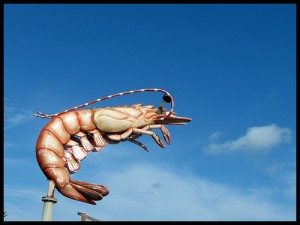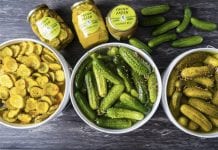 by Elizabeth Grossman, Author of Chasing Molecules: Poisonous Products, Human Health, and the Promise of Green Chemistry, High Tech Trash: Digital Devices, Hidden Toxics, and Human Health
by Elizabeth Grossman, Author of Chasing Molecules: Poisonous Products, Human Health, and the Promise of Green Chemistry, High Tech Trash: Digital Devices, Hidden Toxics, and Human Health
via The Pump Handle
In mid-June most of the seafood shacks along the bayou roads between New Orleans and Grand Isle were closed. A seafood market that I stopped by on the western edge of New Orleans was virtually devoid of customers despite bins brimming with bright blue crab and tawny shrimp. Business was so slim that two women who should have been tending to customers were playing Yahtzee. “We’ve never done this on a workday before,” they told me. Another woman unloading sacks of shrimp frowned at my notepad and said, “I blame the media. We’ve got plenty of shrimp and it’s safe.” She wouldn’t tell me where her shrimp came from, but the woman tending a nearby stall said theirs were inland rather than coastal shrimp.
Even if not one more drop of oil flows into the Gulf of Mexico from the ruptured Deepwater Horizon well, given that nearly 200 million barrels of oil have entered those waters – the AP “spill meter” estimate based on the 35-60,000 barrels a day – chased by nearly 2 million gallons of chemical dispersants, seafood safety will remain a question for some time to come.
Based on the presence of oil in specific areas of the Gulf – and in fish and shellfish – federal and state agencies are determining which areas should be closed to fishing and overseeing the safety of seafood destined for markets. Consumers’ confidence in the agencies doing these jobs will influence their willingness to purchase Gulf seafood – and may even affect how consumers feel about seafood from other places.
Closing Areas to Fishing
Nearly 84,000 square miles of the Gulf of Mexico have been closed to fishing since July 13th. But on Thursday afternoon, July 22, NOAA (National Oceanic and Atmospheric Administration) – NOAA’s jurisdiction begins 3 miles off shore and they’ve been working in tandem with the states that oversee near-shore waters – re-opened 26,388 square miles of this area, along what’s called the Florida shelf, which, at its closest, is 190 miles from the well site. “There been no oil in this area for over a month,” explained NOAA administrator Jane Lubchenco during a call with reporters.
“Today’s decision is good news for Gulf fishermen and American consumers,” said Commerce Secretary Gary Locke in a statement, and “provides important assurance to the American people that the seafood they buy is safe and protects the Gulf seafood brand and the many people who depend on it for their livelihoods.”
On the 22nd the state of Alabama also announced that limited areas of Mobile Bay will be open to shrimping beginning 6 a.m. on July 23rd. “We collected shrimp in June and sent them off for analysis. No (oil compounds) were found,” state biologist John Mareska told the Mobile Press-Register.
NOAA cautions, “Modeling and mapping the actual and projected spill area is not an exact science. NOAA Fisheries Service strongly advises fishermen not to fish in areas where oil or oil sheens (very thin layers of floating oil) are present, even if those areas are not currently closed to fishing.”
According to NOAA, the federal agency responsible for fishing regulations, the most important first step in ensuring seafood safety where there’s been an oil spill is to close the area to fishing. During a July 22 press call, Dr. Lubchenco explained that oil was tracked visually, including on overflights, as well as with subsea and water sampling testing by NOAA research ships. After that comes testing the seafood itself by NOAA along with the FDA (Food and Drug Administration).
Sniffing Seafood
“Crude oil has the potential to taint seafood with flavors and odors imparted by exposure to hydrocarbon chemicals. The U.S. Food and Drug Administration regulates the presence of hydrocarbons as a possible adulterant in seafood,” explains a NOAA factsheet on oil spill seafood safety. The first line of testing defense against oil-contaminated seafood is what’s technically called “sensory analysis,” explains Steven Wilson, Chief Quality Officer of NOAA’s Seafood Inspection Program – in layperson’s terms: sniffing. “The concept is simple,” Wilson tells me in an interview. “The brain is good a differentiating odors and flavors, at differentiating what’s acceptable and not acceptable.” According to NOAA, sensory testing experts can detect aromatics associated with oil down to parts per million.
NOAA’s battalion of expert sniffers are trained to fine-tune their senses to detect aromatic compounds – the hazardous chemicals that are the hallmarks of oil contamination, Wilson tells me. These tests have repeatability and confidence criteria, he explains. And they are backed up by chemical testing. But since it’s not possible to test every piece of seafood, the sampling is representative, with the affected geographic area divided into sampling stations. There are currently 30 such stations in the Gulf, says Wilson. “Seventy percent of the testers must pass samples from a single station as clean, and if any one sample fails, that station fails,” he explains.
The situation in the Gulf is challenging in terms of determining where seafood won’t encounter oil since so much oil has entered the water column and is now so widely dispersed. “It’s very difficult to deal with while the oil can come back [to any one place],” says Wilson. The area of the Gulf just reopened to fishing will stay under ongoing surveillance for oil and dockside seafood testing for the next 30 days.
“Much of this area was not oiled,” said Dr. Lubchenco of the Gulf area re-opened to fishing. “I feel confident that this seafood is very safe to eat,” she said.
Despite this rigor, what seems to remain somewhat unclear is how specifically NOAA and the FDA are testing for the presence of dispersant chemicals in seafood. Wilson told me they were not when we spoke earlier in July. This also came up under questioning of EPA and NOAA witnesses at the July 15th Senate Appropriations Committee’s Commerce, Justice, Science and Related Agencies Subcommittee hearing on the use of chemical oil dispersants in the Deepwater Horizon response.
“Is FDA testing for dispersants [in seafood]?” asked Senator Lisa Murkowski (R-AK). “Our seafood tests are for oil. They’re not specifically looking for dispersants or by products of dispersants,” explained Dr. Larry Robinson, NOAA assistant secretary of commerce for oceans and atmosphere.
EPA Administrator Lisa Jackson explained that because the dispersants being used are made up primarily of petroleum products, screening for oil in seafood would also catch these hydrocarbons. Further, she explained, bioaccumulation studies and models conducted thus far indicate that the other chemical constituents of these dispersants don’t stick around.” EPA, while not a regulator of seafood, is the agency responsible for approving chemicals used in oil spill mitigation. Impacts on marine life is an essential part of that process.
But, acknowledged Larry Robinson under further questioning, “This is something on our list of things we’d like to know more about.”
Even if the non-hydrocarbon chemical components of dispersants don’t bioaccumulate, that doesn’t mean they won’t be present, notes Jackie Savitz, senior campaign director for the NGO Oceana’s pollution campaigns. “I think we should be taking a more precautionary approach,” she says.
Consumer Perceptions
Under these circumstances, asked Murkowski, “How do we give the consumer assurance?”
“To people in the Midwest of this country, seafood is seafood and if they don’t know where it comes from people err on the side of not eating it,” said Murkowski, noting that questions about Gulf seafood has an impact on seafood as far away as Alaska. “Without that confidence, it’s going to be hard to bring back that market,” she pointed out. Her words reminded me of the empty New Orleans area seafood market.
Concerns about consumer perceptions also arose during the July 22nd NOAA press call. “We have talked to several fishermen today in our area. We thought they would be excited about areas reopening, but they were actually more concerned saying this decision was made to soon and wondering who would be held responsible if seafood caught from these waters being reopened does make someone sick? If that does happen, who will be held responsible?,” asked Steven Norris, reporter with WPMI, a Mobile, (AL) TV station.
“The testing is very rigorous testing, and we are able to detect very, very small amounts of potential contaminants in seafood, and every single one of the samples that was tested from this region is clean. And so, for this particular area, we feel very confident that the seafood is completely safe to eat,” replied NOAA administrator Jane Lubchenco. “I would feel completely comfortable eating any seafood from this area that we are opening today,” she said.
Despite these assurances, questions remain – particularly about contaminants we can’t see, smell or taste – especially as storms blow in pushing oiled and dispersant-laden water with increased vigor. “Are you at all wary of eating seafood from the Gulf after the oil disaster? – Vote Now,” asks a July 23rd poll on the website for Local-15TV, the Mobile-Pensacola area NBC affiliate.
Elizabeth Grossman is the author of Chasing Molecules: Poisonous Products, Human Health, and the Promise of Green Chemistry, High Tech Trash: Digital Devices, Hidden Toxics, and Human Health, and other books. Her work has appeared in a variety of publications including Scientific American, Salon, The Washington Post, The Nation, Mother Jones, Grist, and the Huffington Post. Chasing Molecules was chosen by Booklist as one of the Top 10 Science & Technology Books of 2009 and won a 2010 Gold Nautilus Award for investigative journalism













